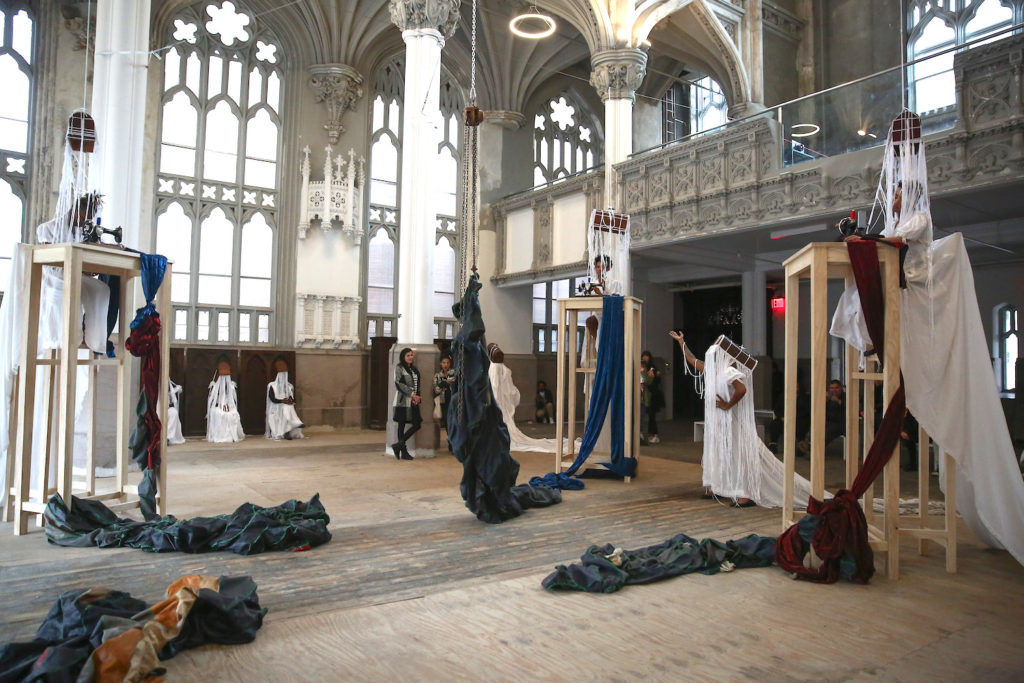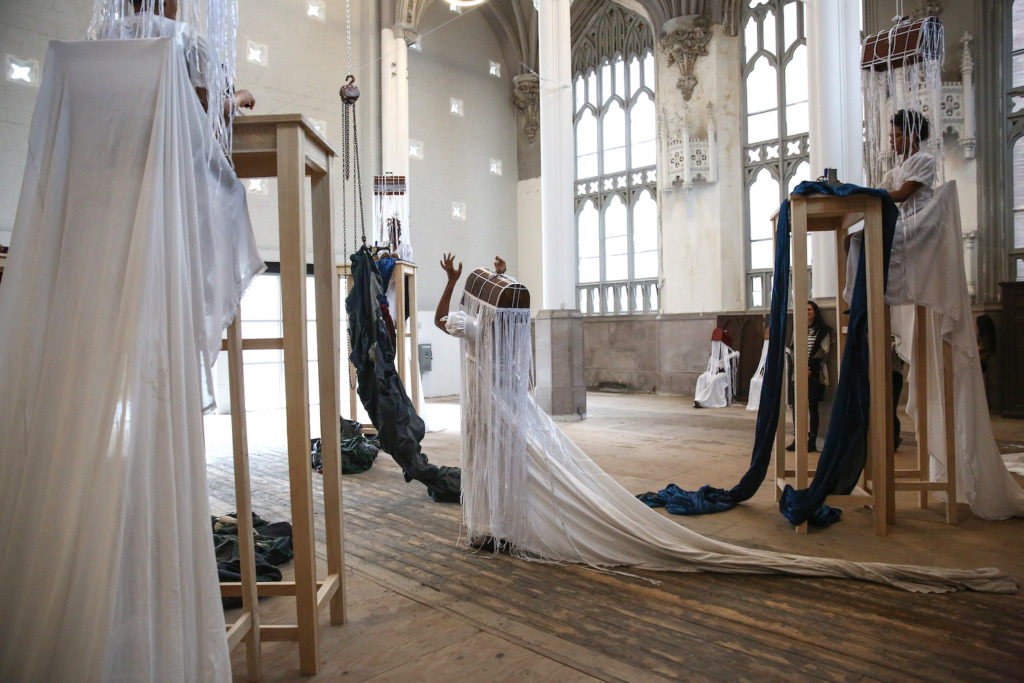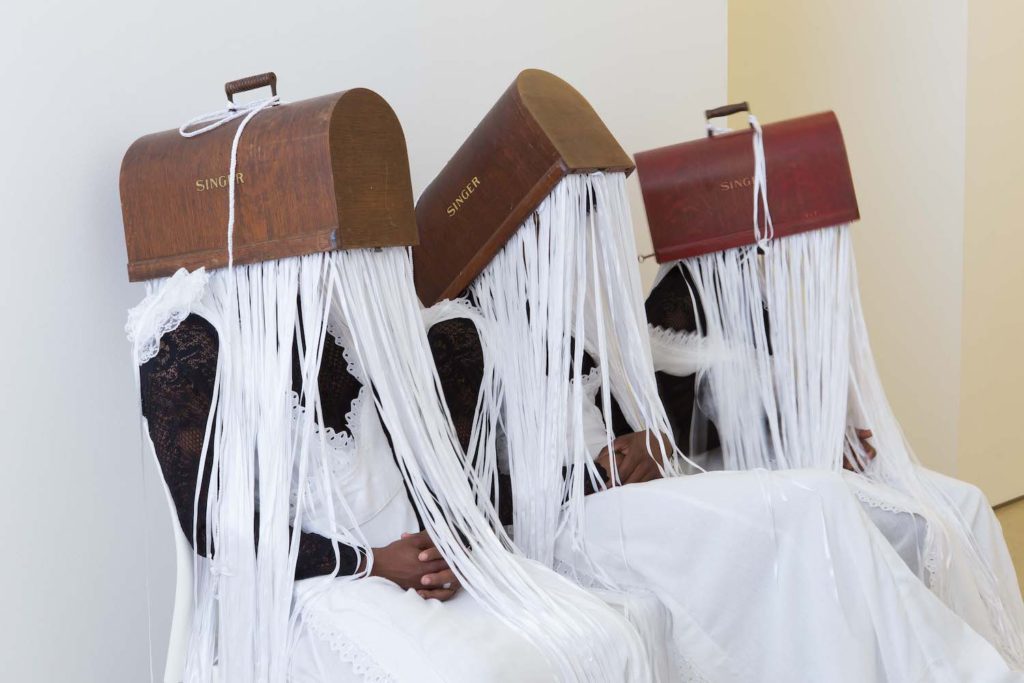
Nicholas Hlobo, umBhovuzo: The Parable of the Sower, 2017, Performa 17 Commission, Installation view Harlem, NY, Photo ©Paula Court
For two days in November, South African artist Nicholas Hlobo took over the Harlem Parish at West 118th Street, for a 2017 iteration of umBhovuzo: The Parable of the Sower. Curated by Performa Founding Director and art historian RoseLee Goldberg, the performance occurred in two-hour intervals on the 18th and 19th of the month and featured a group of nine black male performers cloaked in white flowing fabric who, all but one, sat in silence. Of the nine, four sat at elevated tables, diligently working at softly humming sewing machines. The protagonist, a figure with a vintage Singer sewing machine Bentwood case equipped with flowing string atop his head, moved through the installation, a train following in his wake. Guttural utterances reverberated through the otherwise empty chapel and at times seemed to be addressed to those present, specific, theatrical and poignant all in the same breath. The chapel was temporarily transformed into a workshop. He was the boss or narrator of experience depending on how the situation was interpreted. Some of his statements were simple directions to the men seated at the sewing machines such as, “Spin on spinners.” Others felt more poetic in nature, directed at no one or nothing in particular but rather perceptive observations of the scenario at hand.
Life is art. Did you think about the threads that you put on your body? Art.
Did you think about the way you walked down the street and said hello to people? Art.
Art.
That’s why we’re here.
This was of course true on multiple levels within the Harlem Parish, since Performa 17 had brought all those present to the chapel. It also relates directly to life and presentation of the self, along with our process of observing others. He continued,
Think of that person who gave you these clothes, your undergarments.
Thank them!
Because it was their stitch that brought us together.
While speaking, the Singer sewing machines buzzed quietly, fabric billowing from the elevated tables spilling towards the floor below.

Nicholas Hlobo, umBhovuzo: The Parable of the Sower, 2017, Performa 17 Commission, Installation view Harlem, NY, Photo ©Paula Court
There are some holes here
because we all have to sway and bend
But that can be fixed, mended.
Think about what you can do.
If you want to walk around, don’t be shy, this is your house too.
Sewers who are sowing. Wonderful. Make it all look like new.
Sew on and sow on and sew on. We are not sewing we are giving, we are putting out!
Just as I see you
They see you too.
This latter statement, functioned as a reminder to those viewing the performance that they were also being watched. Through the layered sheath of string, those who worked quietly at their respective sewing machines, or others who assumed sculptural positions on the sidelines, observed those who were present just as they were being observed. In 2007 Simon Njami curated the first ever African Pavilion at the Biennale di Venezia. The first paragraph in Njami’s accompanying catalogue text titled “The Shock of Being Seen,” begins with a quote from Jean-Paul Satre’s Black Orpheus written in 1948. In excerpt,
“The white man enjoyed three thousand years of the privilege of seeing without being seen; he was pure look, the light in his eyes extracted each thing from the shadows of its birth, the whiteness of his skin was also a look, a concentration of light. The white man –white because he was a man, white as day, white as truth, white as virtue– illuminated creation like a torch, revealed the secret white essence of beings. What did you expect when you untied the gag that had silenced these black voices? That they would sing your praises? When these black heads that our fathers had forced to bow down looked up, did you think you would read adoration in their eyes? Here are black men standing before us and I hope that you, like me, feel the shock of being seen.”

Nicholas Hlobo, umBhovuzo: The Parable of the Sower, 2016, ©Nicholas Hlobo, Installation view Stevenson Gallery, Cape Town and Johannesburg Photo Mario Todeschini
This text echoed in my mind throughout Hlobo’s performance. As I stood, then sat in thoughtful examination, watching as autumnal afternoon light streamed through the south-facing windows, I was suddenly aware of being watched. The performance in that moment was more than a performance and functioned entirely as work of art; relating the external world with the internal world, the impersonal with the familiar and the process of looking juxtaposed with that of being seen. The open format of umBhovuzo: The Parable of the Sower, allowed those present to sit in observation or walk through the installation releasing any sense of distance between performer and viewer/audience member. Immediately revealed in the title of the performance, Hlobo is playing with words, using action along with diaphanous masking of the body. Several men are sewing while one sows with discourse, a vehicle of thought exercised through movement and poetic musing.
From Njami’s essay,
Sartre’s words should thus be read as an opposition between colonial powers and colonised peoples. Which means the shock of being seen is no longer just an ontological experience, it is part of a political approach of awareness.
Then later continuing,
In this game of mirrors, the transformation of the Other’s status leads to another relationship to the self. By seeing, the ex-colonised switches from object to player, putting himself in a position to use what Merleau-Ponty calls his “seeing power”: “My body is both seeing and visible. He who looks at all things can also look at himself, and then recognise in what he sees the ‘other side’ of his seeing power.” The first effects of this metamorphosis that stretched (bar a few exceptions) from the 1950s to the early 1980s –or even to the 1990s with the fall of apartheid and the installation of the peace process in Angola– were the end of colonisation and the advent of African independences.
Nicholas Hlobo is an artist from Cape Town, currently based in Johannesburg and has exhibited in institutions ranging from the Museum Beelden aan Zee, The Hague in 2016 to the Tate Modern in 2006, amongst others. What he brought to the Harlem Parish was truly an experience that had the power to bridge continents. Through accessing universal gestures that bind the fabric of humanity, his work was not only visually stunning and engaging but also offered an underlying didactic thread, a reminder that things can be mended. Often times what initially may appear abstract or indecipherable is actually a manual for how things should be done if we are willing to listen, look and be seen.
_____________________________________________________________________________________
The Performa 17 Biennial took place in New York City from November 1-19, 2017. The history anchor for 2017 was DADA with a focus on artists from Africa.
Katy Diamond Hamer is the Founder and Editor in Chief of Eyes Towards the Dove. She contributes to several publications and can be found on Instagram @katyhamer
